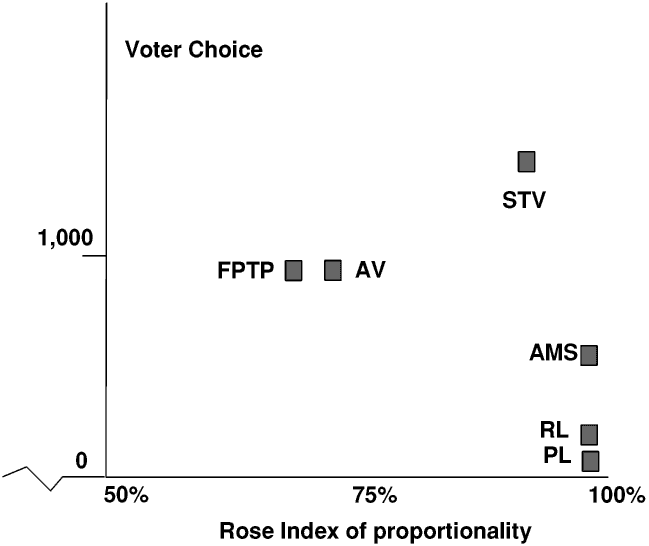Up: Issue 9
Next: Paper 4
Previous: Paper 2
Voting matters - Issue 9, May 1998
Voter Choice and Proportionality
B A Wichmann and R F Maddock
At the Electoral Reform Society 1997 AGM, Hugh Warren produced an
eye-catching diagram in which several electoral systems were plotted on a
diagram in which the two axes were voter-choice and proportionality. The
diagram was not intended to give precise measures of the characteristics of
each electoral system, but merely their relationship. However, for (party)
proportionality, the Rose Index is a reasonable approximate measure. For
voter- choice, no existing measure appears to be available which would be
necessary to provide a more accurate representation of the diagram.
A possible measure of voter choice is the information-theoretic value of the
result of an election, which appears to be new. For instance, in a
dictatorship which has mock elections, the result is known beforehand, and
therefore the information-theoretic value is zero. On the other hand, if the
electorate is given a choice between three candidates then, assuming that
each outcome is equally likely, the information-theoretic value is
log2(3)=1.58. As the number of possible outcomes increases, so
does this measure of voter choice.
For values of the Rose Index, Kestelman gives values for
the major electoral systems. It must be acknowledged that the Rose Index as
a measure of party proportionality, may not be appropriate for STV
elections, as pointed out by David Hill.
We compute the values for a hypothetical election for a 600 seat assembly in
which there are three parties. For the use of STV, we take 120
constituencies each electing 5 members. For the regional list, we take 10
regions electing 60 candidates each. For the additional member system, we
assume 300 seats elected directly and 300 added by proportionality. Note
that if n seats are to be filled with 3 parties, then the number of
ways to do this is n2/2+3n/2+1. We assume that all
possible outcomes are equally likely. The entries in the diagram are as
follows:
- First Past The Post (FPTP): Rose Index 70% (UK), voter choice is
600 log2(3)=951.
- Alternative Vote (AV): Rose Index 72% (Australia), voter choice
is
600 log2(3)=951.
- Single Transferable Vote (STV): Rose Index 92% (Ireland), voter
choice is
120 log2(5C15)=1386.
(We are assuming each party has five candidates and therefore could
theoretically obtain all five seats; hence the number of possibilities is
the number of ways of selecting 5 from 15.)
- Additional Member System (AMS): Rose Index 98% (estimated),
voter choice
300 log2(3)+log2(3002/2 +3×300/2+1)=491.
- Party List (PL): Rose Index 98% (estimated), voter choice is
log2(6002/2+3×600/2+1)=17.5.
- Regional party Lists (RL): Rose Index 98% (estimated),
voter choice is
10 log2(602/2+3×60/2+1)=109.
It is important to note that this diagram will change if the underlying
assumptions are changed, for instance, if the number of parties was
increased from 3 to 4. An alternative way to compute voter choice values
would be to take into account the probability of the various outcomes, based
upon appropriate statistical data. This was considered initially but
rejected due to the difficulty of the calculation and the problems in
finding appropriate statistical data. If the voting system was changed, then
one can only guess at the future statistical data. (The diagram here has the
x-axis reflected from Hugh Warren's version so that the Rose Index is
increasing.)

The conclusion from this diagram is hardly unexpected: party lists do not
give voter choice, and FPTP/AV do not give party proportionality, while STV
can claim, to a reasonable degree, to provide both.
References
- P Kestelman. Is STV a form of PR? Voting matters.
Issue 6. p5-9.
- I D Hill. Measuring proportionality. Voting matters.
Issue 8. p7-8.
Up: Issue 9
Next: Paper 4
Previous: Paper 2